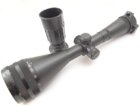Please pardon my bringing this thread back again, but I have a practical, as opposed to theoretical question.
Is there anywhere available a table or list of claimed % light transmissions for all, or at least a good % of common rifle scope brands/product lines?
I can find these for a few, such as recent Leupold product lines. But a LOT of manufacturers either don't care to disclose or one must hack through quite a bit to locate a hard number online.
Additionaly, when I find a single % transmitted figure given for a whole product line which includes both fixed and variable power models? And knowing that these models have different numbers of total lens surfaces?! I suspect the number provided might not be accurate for all... unless they used lower quality coatings for the fixed powers, which I SUPPOSE might be done.
I am trying to use the % light transmitted figure along with twilight factor to get a better idea of what performance to really expect in low light.
Is there anywhere available a table or list of claimed % light transmissions for all, or at least a good % of common rifle scope brands/product lines?
I can find these for a few, such as recent Leupold product lines. But a LOT of manufacturers either don't care to disclose or one must hack through quite a bit to locate a hard number online.
Additionaly, when I find a single % transmitted figure given for a whole product line which includes both fixed and variable power models? And knowing that these models have different numbers of total lens surfaces?! I suspect the number provided might not be accurate for all... unless they used lower quality coatings for the fixed powers, which I SUPPOSE might be done.
I am trying to use the % light transmitted figure along with twilight factor to get a better idea of what performance to really expect in low light.
Last edited:












